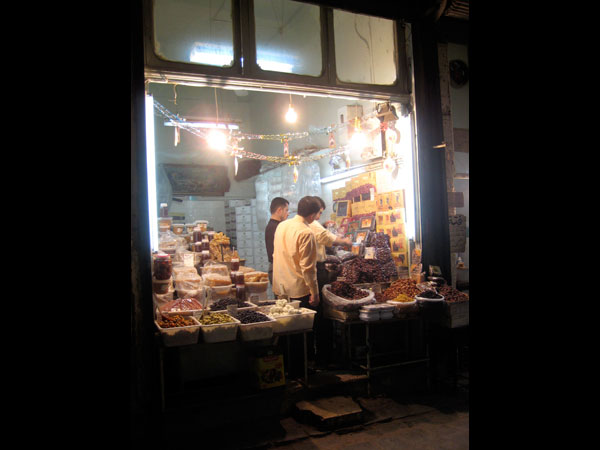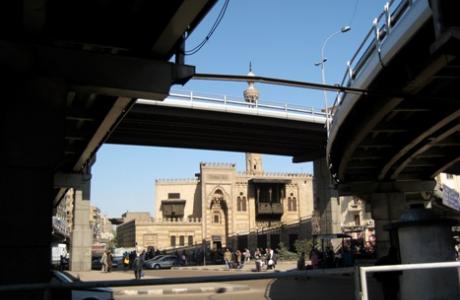
Mohamed Atta became an architect at Cairo University, in the city where he came of age. The Egyptian capital is a fascinating, albeit poorly maintained, open-air museum, spanning 5,000 years of architectural history. In its recent past—since Napoleon's 1798 invasion, in Egypt's near-geologic time frame—the city has lurched from Western model to Western model, trying in vain to reclaim its lost glory. In the Abdin neighborhood where Atta grew up, grand Parisian apartment buildings constructed in the 19th century now sit caked in dust, their windows shattered. Downtown, along the Nile, 20th-century highways and high-rises modeled on those of Houston and Los Angeles create a traffic-clogged nightmare, as the carless masses of Cairo dart across eight-lane expressways using one another as human shields.
In the rotting modernist slab that is the Cairo University architecture department, students and professors work toward a contemporary architecture that reconnects to the pre-Napoleonic past. A senior project displayed in its halls offers a Frank Lloyd Wright quotation of surprising relevance to the Egyptian conundrum: "Without an architecture of our own we have no soul of our own civilization." Though the faculty encourages students to forge a new synthesis of past and present in their work, many students turn in what professor Aly Hatem Gabr calls "cut-and-paste" architecture, dropping nostalgic designs right out of the 1600s into their proposals for contemporary Egypt.
After graduating from the university in 1990, Atta worked briefly as an architect in Cairo and studied German at the city's Goethe Institute. In 1992, he began his graduate studies in Germany and worked part-time as a draftsman at a Hamburg urban design firm. In the summer of 1995, he returned to Cairo on a research fellowship to evaluate plans for historic preservation, traffic control, and tourism promotion in the city's Islamic Quarter. (The fellowship was funded by the Carl Duisberg Society, a German institution that supports research on the developing world.) The Islamic Quarter, which houses the world's greatest collection of medieval Muslim monuments, was collapsing in humiliating fashion: Inadequate sanitation had so contaminated Cairo's water table with human waste that it was eroding the buildings' limestone foundations.
Packed with historic sites and teeming with impoverished residents, the Islamic Quarter has long struggled to balance the needs of tourists and locals. At the southern end of the neighborhood, merchants in the historic Khan el-Khalli souq hawk hookah pipes and Nefertiti busts to tourists. Up the narrow main street, light industry appears, providing employment for locals but little ambience for vacationers. Despite the invaluable monuments, the neighborhood, with its mix of crumbling historic homes and poorly built high-rises, doesn't feel like a historic district. As Nasser Rabbat, a Syrian-born MIT architecture professor who has published on Islamic Cairo, told me while on sabbatical in the city, "it's so dirty that even those of us who are enamored with the architecture think twice before going to look at the architecture."
Despite the shocking condition of the neighborhood's treasures, Atta found the government's proposed solution even worse, according to Ralph Bodenstein, one of Atta's German fellowship partners. He spoke to me at his office in Cairo, where he now lives and works as an architectural historian and professor. The fellowship team secured an interview with the governor of Cairo, who laid out his vision for the district: The residents would be evicted, smaller structures around the monuments (like the tiny stalls that are Cairo's answer to the convenience store) would be leveled, and the district would be turned into a park for tourists. "He wanted the guards working there to wear historic costumes," Bodenstein recalled with an incredulous grin. "So if it's a Mamluk monument, they should wear Mamluk costumes, and if it's a Fatimid monument, they should wear Fatimid costumes. He was very fond of the idea. He was really, really proud." Atta was appalled, Bodenstein said. It seemed that in the governor's eyes, tourists were more important than the citizens he supposedly served.
The governor's fanciful plan was something of a trial balloon—a standard way of soliciting a modicum of public input in Egypt's undemocratic system—but Atta knew that eviction was not an idle threat. At the time of the fellowship, preservationists from France were restoring the northern wall of the medieval city of Cairo, and the Egyptian authorities were evicting the people living along it. "We discussed the northern-wall issue because they were throwing the people out," Bodenstein recalled. "And he was very critical of that. He thought that was a price for tourism that should not be paid." These contemporary plans echoed a familiar theme in the history of preservation efforts in Cairo. From the start in 1880, with the founding of the Comité des Monuments de L'Art Arabe, a French-run historic preservation group, protecting Cairo's architectural heritage has been a project driven by Westerners with few scruples about using evictions to save Egypt from the Egyptians.
While secular preservationists like Bodenstein saw the government's actions as the natural impulse of an undemocratic state heavily dependent on foreign tourism for revenue, in Atta's mind, they may have seemed like something darker, part of a Western-dominated world system designed to humiliate Muslims. Atta's worldview was fanatically conspiratorial, as documented in Lawrence Wright's The Looming Tower, Terry McDermott's Perfect Soldiers, The 9/11 Commission Report, and elsewhere. In Atta's imagination, the United Nations refused to intervene during the Bosnian genocide because of its anti-Muslim prejudice and Monica Lewinsky was a Mossad agent, sent to bring down President Clinton for his growing sympathies toward the Palestinians. That the fair-skinned colonials of the Comité had been replaced by the Egyptian officials of a repressive, U.S.-backed regime would only have made the conspiracy more sinister. This worldview, in which the historical trespasses of the Western powers are exaggerated into a vast, ongoing, anti-Muslim conspiracy, unfolding on blueprints as well as battlefields, would color Atta's master's research in Aleppo, Syria, where he would devise his own misguided plan for historic preservation.



